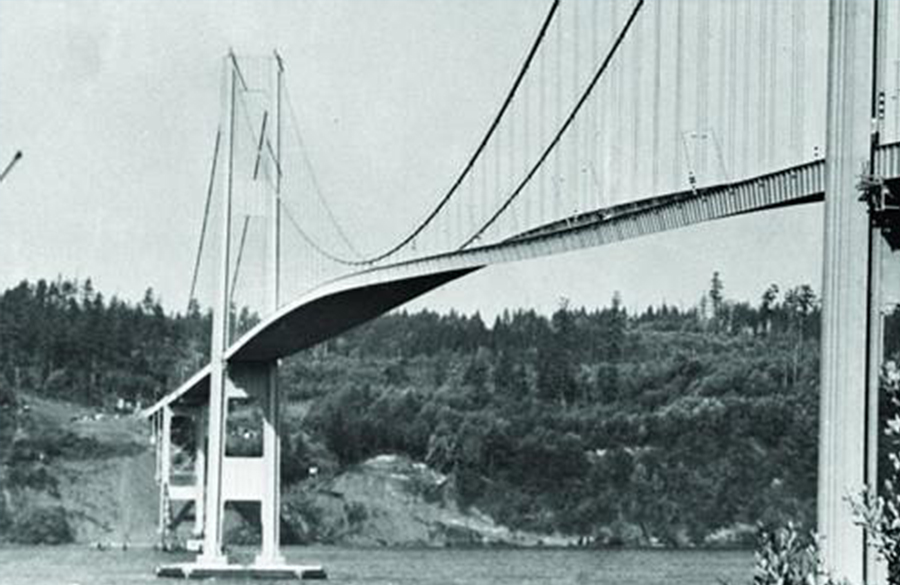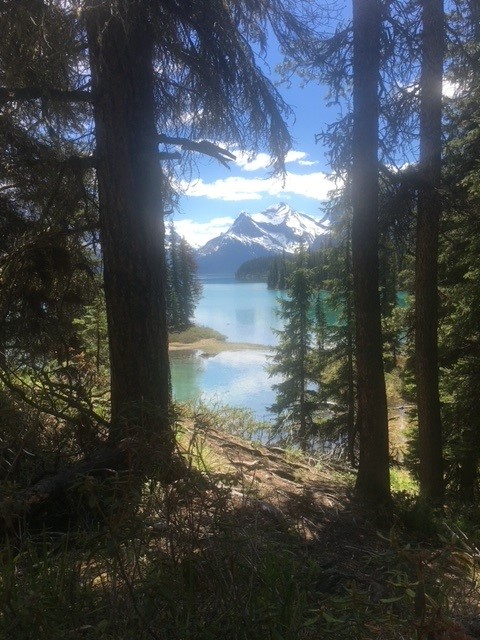Elegant and slender compared to earlier suspension bridges, the third longest suspension bridge in the world opened in 1940. It featured tall towers and a thin roadway featuring solid steel beams rather than the conventional truss construction. Leon Solomon Moisseiff, its designer, had been instrumental in the Manhattan Bridge, the Golden Gate Bridge and the Benjamin Franklin Bridge in Philadelphia. He strongly believed in a design theory he created called “deflection theory.” His bridges were designed to be more flexible than conventional bridges – to bend rather than break. An idea that worked brilliantly on paper and for the first four months the bridge was open. Until the wind picked up.
As the wind passed through the Puget Sound through the Tacoma Narrows, it accelerated. Passing over and under the thin roadway the wind did something unexpected – it created lift. As impossible as it sounds, the new bridge started to flutter in the wind! As the picture below shows, Moisseiff’s Tacoma Narrows Bridge, later dubbed Galloping Gertie, certainly achieved his goal of flexibility.

Source: Wikipedia
Unfortunately, that flexibility quickly led to its collapse.

source: Wikipedia
I watched the video of the Galloping Gertie Bridge collapse as a young architecture student – mesmerized. It oscillated wildly exhibiting “aeroelastic flutter,” prior to self-destructing. How could such a skilled engineer get it so spectacularly wrong? In the end, Moisseif’s obsession with “deflection theory,” making bridges lighter and more narrow led to both his and the Tacoma Narrows’ Bridge’s downfall. You and I have seen this process play out many times.
Long-Term Capital Management (LTCM) is the Galloping Gertie of the financial world. John Meriwether founded Long-Term Capital Management along with Nobel laureates Myron Scholes and Robert Merton, as well as other prominent traders and academics. This team of academic heavyweights believed they had the Midas touch. Everything went well until the wind picked up during the 1998 Russian financial crisis. Calamity ensued and LTCM’s investments began to flutter, then it failed catastrophically.
Sound familiar? Time and again this story plays out. Genius morphs into hubris and when mixed with leverage, turns into disaster. It’s not just bridges and finance. These stories are so familiar and ubiquitous that successful investors have learned to “tune them out.” Maybe that’s an evolutionary adaptation for survival! Charlie Munger famously says, “Rule #1 is don’t lose money. Rule #2 is don’t forget rule #1.” It’s one of the reasons that I am so rigorous about risk management. Charlie reminds investors to keep the main thing, the main thing.
That’s a lesson that ought to be applied more frequently in other domains. For instance, watching the devastation around Jasper this past week was equal parts heart-breaking and infuriating. I’ve had the joy of being in the Rockies twice in the past few years – I was struck then at the staggering amount of standing dead pines killed by the Mountain Beetle. I took the photo below at Maligne Lake just outside of Jasper. A constant threat, wildfires were burning while we visited and ash was dropping from the sky as far south-east as Banff.

Maligne Lake (40 kilometers from Jasper, Alberta) photo: G. Evans
Appropriately, when questioned about the risk of standing dead pines around Jasper, then Federal Minister of the Environment and Climate Change Catherine McKenna rose in the House of Commons to acknowledge the risk and confirm that “… the protection of our National Parks was her first priority,” that was 2017. Jasper National Park may not have been fluttering like Galloping Gerty but the wind was surely picking up – source.
We can and should debate the pros and cons of carbon taxes, single use plastics as well as the budget for forest fighting at the provincial level. I welcome the debate, but surely, we can agree to cut down the dead trees! Those of us who believe climate change is a real threat have no excuse not to prioritize the removal of excess forest tinder, creating fire breaks, controlled burning, building levees and dykes, as well as restoring flood plains. We need to keep the main thing, the main thing!
For our part, Briana and I will continue to make sure we heed Munger’s words.
Glen
